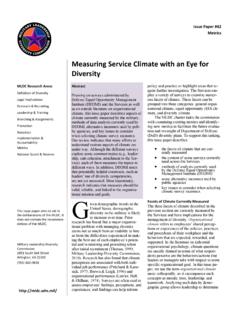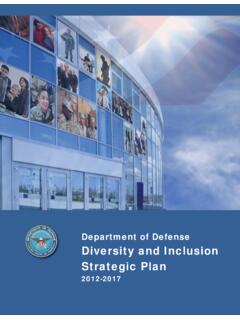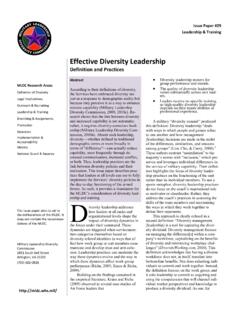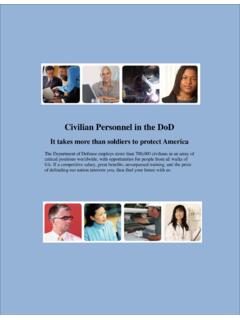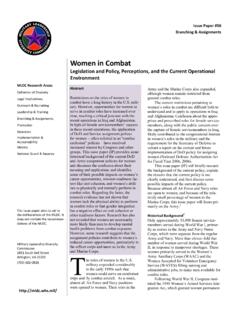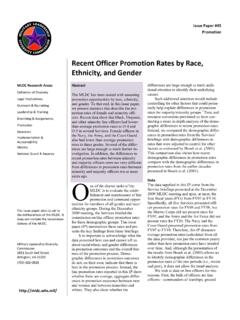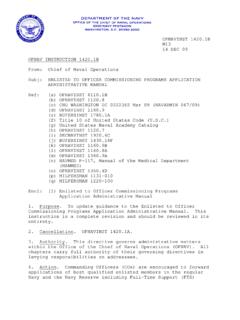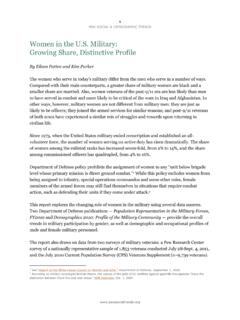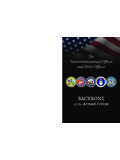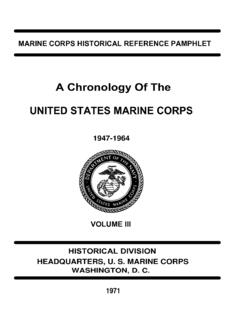Transcription of Demographic Profile of the Active-Duty Enlisted Force
1 Manpower Data Center (DMDC) for all five Services. To give a complete picture, we report both percentages and their underlying counts. Percentages allow the reader to make com-parisons across the Services despite their dif-ferences in size. The counts show how much the Services vary in size. Interpreting the Data: Care Is Required This IP is primarily descriptive in nature, and the information presented limits the conclu-sions that can be drawn from it. We do not attempt to determine why differences or simi-larities across the Services may exist. There-fore, it would be incorrect to interpret the re-sults presented here as evidence of the pres-ence or lack of discrimination in any Service.
2 Other IPs will consider factors that may have created differences across the Services. Any variations in percentages and counts re-flect the combined impact of institutional and structural differences across the Services, such as differences in the career-field mix and Demographic distributions across career fields the application of the combat-exclusion laws accession profiles over time differences in average individual preferences to serve in one Service rather than another policies diversity climate. Female Enlisted Personnel Figure 1 compares the percentages of female Enlisted personnel in ranks E1 E6 with those in ranks E7 E9.
3 Table 1 shows raw counts, including the total number of Enlisted person-nel and the breakdown of men and women. Demographic Profile of the Active-Duty Enlisted Force September 2008 Snapshot This issue paper aims to aid in the deliberations of the MLDC. It does not contain the recommen-dations of the MLDC. Issue Paper #19 Implementation & Accountability Abstract In this issue paper, we present a consistent Demographic Profile of the Active-Duty Enlisted corps across the five Services. We separate personnel in ranks E1 E6 from those in ranks E7 E9, and we display the data in charts and tables by gender and race/ethnicity categories.
4 Data are reported as percentages and as raw counts to facili-tate comparisons and illustrate differences in magnitude. Although the data presented here are in the form of 2008 snapshots, we also provide an appendix with yearly data starting in 2000. MLDC Research Areas Definition of Diversity Legal Implications Outreach & Recruiting Leadership & Training Branching & Assignments Promotion Retention Implementation & Accountability Metrics National Guard & Reserve Military Leadership Diversity Commission 1851 South Bell Street Arlington, VA 22202 (703) 602-0818 D uring the September 2009 meet-ing of the MLDC, each of the Services presented a briefing with basic Demographic statis-tics.
5 However, because each Service gave slightly different information in a different format, it proved difficult to make compari-sons across Services. Therefore, we have developed a series of issue papers (IPs) to present consistent profiles of gender and race/ethnicity across all the Services, focus-ing on five specific groups: Active-Duty officers Active-Duty Enlisted Active-Duty warrant officers Reserve National Guard1 This IP looks at the Active-Duty Enlisted population. Data In the main text of this IP, we provide Demographic snapshots of the Active-Duty Enlisted population from September 2008; the appendix contains yearly snapshots from 2000 2008.
6 To ensure consistency, we use a common dataset from the Defense Points to Take Away from Figure 1 Regarding the E1 E6 female shares, The Air Force , with percent women, and the Marine Corps, with percent women, stand out, with the highest and lowest female shares. The Army, with percent women, and the Coast Guard, with percent women, have similar gender profiles. The Navy has slightly higher female representation, with percent women. Regarding the E7 E9 female shares, There is less variation among the Services sen-ior ranks. The female share of the population in ranks E7 E9 is between percent and percent, whereas it is between percent and percent in ranks E1 E6.
7 Note, however, that, across the board, the female shares are smaller in the senior ranks. Once again, the Air Force , with percent, has the largest share of women, and the Marine Corps, with percent, has the smallest. The Army, with percent women, follows the Air Force ; and the Navy and the Coast Guard are made up of percent and percent women, respectively. Using the percentages, we calculated ratios to determine how closely the senior Enlisted ranks mirror the E1 E6 population within each Ser-vice. For example, in the Coast Guard, per-cent of servicemembers in the senior Enlisted ranks are women; in the E1 E6 group, percent are women.
8 The ratio, then, is ( = ). The ratios of female Enlisted personnel in ranks E7 E9 to those in E1 E6 in the remaining Services are as follows: Air Force = , Army = , Marine Corps = , and Navy = The Army and the Ma-rine Corps stand out because their ratios are relatively close to Their ratios show that the percentage of women in the lower ranks is similar to that in the senior ranks. MLDC Issue Paper #19 Page #2 March 2010 Figure 1. Percentage of Female Enlisted Personnel by Service and Grade, September 2008 Service E1 E6 E7 E9 Total Male Female Total Male Female USAF 224,152 177,322 46,830 33,940 29,367 4,573 USA 396,534 342,919 53,615 55,531 49,443 6,088 USCG 28,851 25,259 3,592 4,364 4,089 275 USMC 164,450 154,057 10,393 13,763 13,043 720 USN 243,363 204,488 38,875 31,928 29,610 2,318 Table 1.
9 Number of Enlisted Personnel by Service, Gender, and Rank, September 2008 Points to Take Away from Table 1 Regarding the E1 E6 ranks, There is significant variation in the size of the E1 E6 population across the Services, ranging from 28,851 in the Coast Guard to 396,534 in the Army. The Air Force and Navy are similar in size, while the Marine Corps is smaller. Regarding the E7 E9 ranks, As in the lower ranks, there is considerable difference in size across the Services, ranging from 4,364 senior Enlisted personnel in the Coast Guard to 55,531 in the Army. The senior groups in the Air Force and the Navy, again, are similar in size, while the Ma-rine Corps group is smaller.
10 Minority Enlisted Personnel In this section, we first combine all racial and ethnic minori-ties2 in order to contrast them with white non-Hispanics (white, NH) and with those whose race/ethnicity are un-known. Later, we examine each race/ethnicity category indi-vidually. Note that because our focus in this section is specifi-cally on race and ethnicity, we do not further categorize by gender. That is, both women and men are included in all cate-gories used in this section. Figure 2 compares the percentages of minorities in ranks E1 E6 with those in ranks E7 E9. Table 2 shows raw counts, including the total number of Enlisted personnel, as well as the number of personnel in each of the following categories: white, NH; minority; and unknown.
